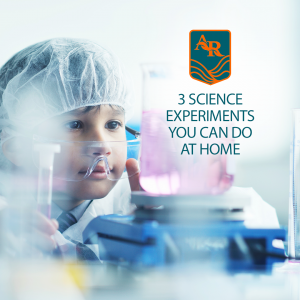
Science isn’t confined to a sterile lab with beakers and solutions. You can learn science literally anywhere, so why not create a little at home lab lesson? Science experiments at home can help our kids learn everything from how certain household items work, to handling messes while they’re made. All the while they’re learning ways to understand how different items, colors, or textures mix together and what kind of reactions take place. There are many lessons to be learned while experimenting at home. Here are three experiments your kids will be excited to try!
Sweet Sugar Gems
You’ve probably seen these before. That delicious and beautiful rock candy you’ve seen in stores for years can be made at home with a few simple ingredients. You’ll need sugar, water, and an item you would like to grow sugar crystals on like a popsicle stick or piece of string.
- Step 1: Bring 1 cup of water to a boil, then remove it from heat.
- Step 2: As the water cools, mix in 3 cups of sugar until well dissolved.
- Step 3 (optional): Add 2-3 drops of food coloring.
- Step 4: Suspend a string, candy stick, or pipe cleaner into a cup-like container. This can be done by tying the item to a butter knife and suspending it over a cup by resting the knife on the cup edges. Be sure the item you’ve intended to grow crystals on does not touch the bottom or edges of the desired container.
- Step 5: Fill the container with the sugar water. As you fill the container with dissolved sugar water, be sure no undissolved sugar is included.
You should find crystals have grown within 24 hours! You can allow them to grow until they’ve reached the desired size or until the growth has stopped.
Tip: These make great party favors for kids of all ages!
Two-Step Edible Play Dough
This is a sweet and simple idea that makes regular play dough seem drab and outdated. For this experiment, encourage your children to mix colors to learn how some colors combine together to make new hues!
To make this, you’ll need one cup of icing, one cup of powdered sugar, and food coloring (optional).
- Step 1: Mix the icing and food coloring together to desired color. Coloring the dough during this step will save your hands from being stained.
Tip: You can separate the icing into smaller portions to make more colors.
- Step 2: Mix in powdered sugar until you reach the desired consistency. The dough should be soft and malleable.
The best part about this experiment? It can be eaten once play is done! If you want to avoid a sugar rush, you can place the dough in plastic bags to save for later.
Learning Liquid Densities
This experiment will resemble the beloved lava lamp that adorned living rooms in decades past. This experiment teaches how oil and water will always remain separated and demonstrates how some substances are denser than others.
You’ll need water, vegetable oil, and food coloring.
- Step 1: Fill a container 3/4 of the way full with water.
- Step 2: In a separate bowl, add vegetable oil and desired food coloring in multiple colors. Mix the oil and coloring. The oil and coloring won’t mix but it will break up the colors in order to make a more mesmerizing experiment.
- Step 3: Pour the container of oil into the water. The oil will begin to rise to the top of the water but the food coloring will begin to slowly mix with the water. Eventually all of the color will fall from the oil and fill the water with streams of vibrant color.
The only question left to ask is, “What experiment are we doing next?!”
